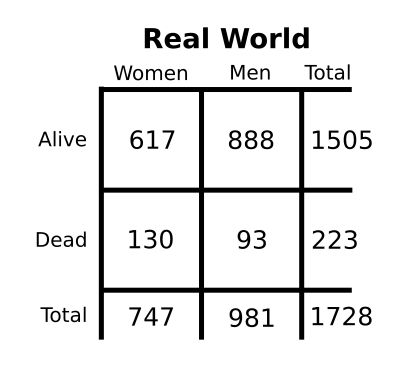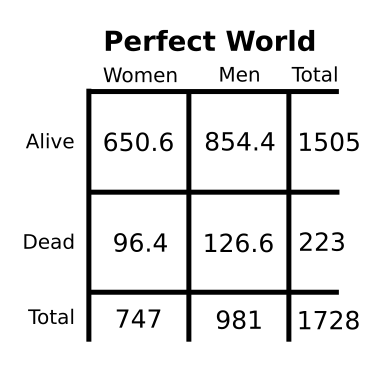1.4 Analysis
Like a lot of stats projects, this analysis has several stages. We start with the descriptive statistics, such as percentages, to get a feel for the data and figure out where to go. From there, we use tests to try and work out if our weird percentages mean anything, or if they’re just because of chance. Finally, to find out what’s happening over time we have to make graphs and draw lines through them - a kind of analysis called linear regression.
Every analysis starts with basic numbers and percentages, since they let us get a feel for what’s going on and what we might need to look for.
In our data there are 1728 characters in total. 981 of them were men and 747 of them were women, so while men are a little more prominent, the gender split is closer to 50/50 than we might’ve thought.
223 of these characters died - 93 men and 130 women. That’s a little surprising; more men overall, but fewer men dying? It might be worth looking at whether gender is having an impact on who dies.
The percentage of women who died overall was 17.4%. This is a lot lower than the 40% claimed by other analysts. Other researchers found their death percentage by comparing Autostraddle’s list of dead queer women (130) to the number of queer women on TV reported by Heather Hogan (383), you get 40%. Yet this statistic has a significant flaw in its construction. The first is that Hogan seems to only have counted american characters, but the death list includes ones from all over the world; it would be like taking all the deaths in the world as a percentage of the American population - a vast overestimate. The reason that this study got a much lower number - 17.4% - is that it compares all the deaths in the world to all the characters in the world; unlike the other attempts, this one is based on a fair comparison.
If we restrict the data to years after 1995 (“modern” tv), when there were enough gay characters around to actually be worth talking about, then the average death rate each year is 3.5% (so 35 out of every thousand characters were dying). This figure is slightly lower for men and slightly higher for women, but it’s within 1% on either side. Specifically in 2016, however, the death rate of all gay characters was 7.4%; if we look at gender, this breaks down into 2.5% for men and 13.3% for women, which seems to reflect the whole “wow, a lot of lesbian characters are dying in 2016” observation that many critics made.
Unfortunately, percentages aren’t proof. All we can do with these numbers is look at them and say “oh, that looks bad”; we have no way of showing that they’re not just the product of chance. As such, this is the point where we have to move beyond the safe, simple realms of basic numbers and into the scary-sounding kinds of statistics that they teach at university. I won’t be using the jargon or showing the calculations here, because they’re complicated and boring; instead, I’ll be using a careful walkthrough of the tests to help get the underlying ideas across. The first question is: if percentages and raw numbers aren’t proof, what is? Over a long time, statisticians have developed a method for showing that results are too weird to be chance, and things shown to be “significant” through this method are considered good enough to be proof. Significance is the measurement of how unlikely we are to get the results that we did; it’s usually expressed as a percentage, and if it’s very small then you’re very unlikely to have got your results if only chance was in play (i.e. there’s something causing your data to look weird).
Now, when you’ve been doing statistics for a long time you develop the ability to look at significance percentages and immediately go “that’s strong” or “that’s meaningless”. I don’t expect you to have those skills, though, so to help you get that impression we’re going to use some extra tools - emojis.
Below is a table of the commonly accepted “levels” of significance. The lower your significance percentage is, the less likely it is that your results are because of chance; we split significance into a bunch of thresholds to make interpreting easier. Level 2 is the highest our percentage can be and still be significant (level 1 exists, but isn’t significant for complicated maths reasons); higher levels mean more significance and therefore more ability to be sure that what we’re seeing isn’t just because of chance.
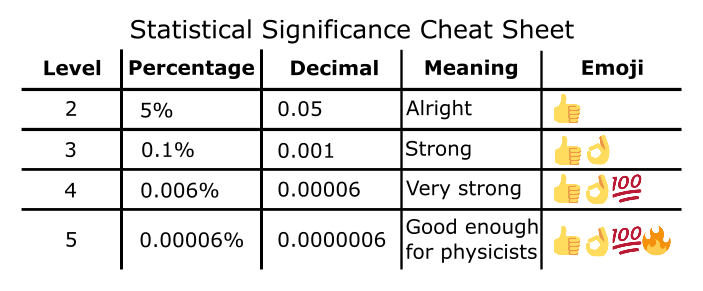
All of this is pretty theoretical, so let’s work through the methods using my two favourite things: death and gender.
1.4.2 Looking Back: Queer Death Over Time
How do we tackle the problem of historical context? We can’t just make a table of death and year; that breaks the test we used (for complicated stats reasons). There’s only one way forward - graphs.
First, we graph the raw number of deaths per year.
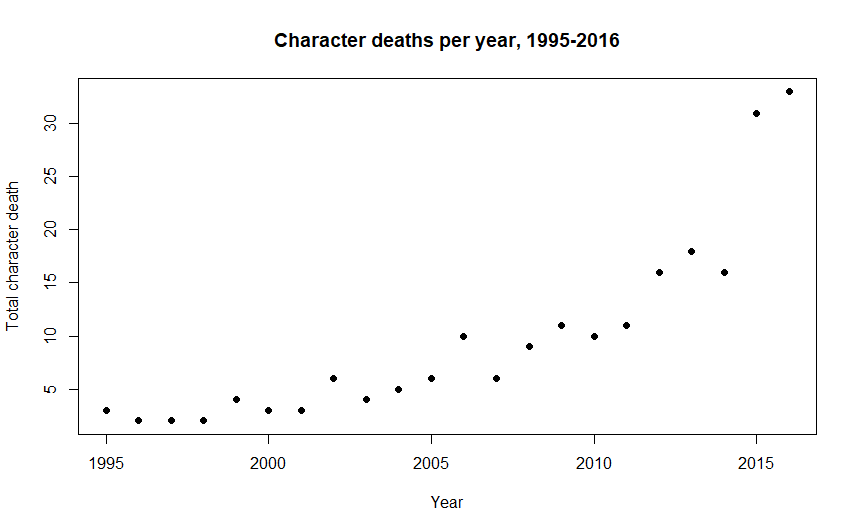
This turns out to be pretty useless; it’s just increasing each year. We’ve fallen victim to the first thing everyone would ask me when I was writing this: “But what if there are more queer characters every year??”
To avoid this issue we use the percent death rate rather than just the number of deaths. This is because the raw number of deaths can’t account for more gay characters on TV turning up. If there are more characters, more should be dying as a result; 1 character dying out of 20 is the same percentage as 50 characters dying out of 1000, and even though 50 looks higher it doesn’t mean there’s anything actually wrong. However, if the proportion of characters dying - which we express with a percentage - is going up, then that can’t be explained by the base number of characters increasing and might suggest that something bigger is going on. The percent death rate looks like this:
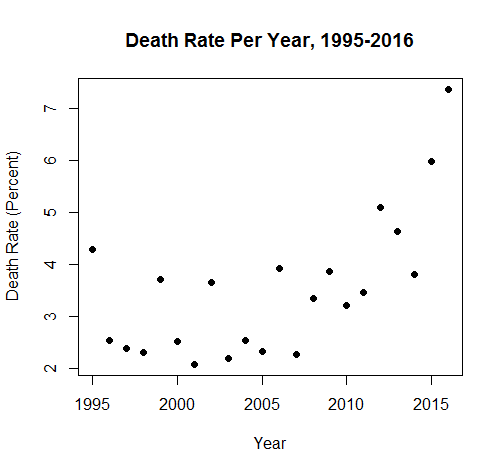
Which is a lot more informative. Glancing at the data “cloud”, it seems like death was pretty stable, but has been increasing recently. As before, though, we can’t just operate by looking at things and deciding that they’re bad: we have to prove it.
In order to make sense of this data we have to put a line through it and test the line. The line acts as a model of the data. If we can put a line through the graph that looks a lot like what’s happening with the data, and the slope of that line changes over time, then we’re able to say that the death rate is changing over the time (because our line says it is).
We have to use more than one iteration of the One Test in this case, because we have to look at a few different things in order to be sure that the line is significant: - The “F test”, which assumes that the line is flat and is significant if it’s not. In order for us to claim that time is related to death, the line needs to not be flat. - The “T test”, which assumes that the effect of time on the death rate is zero (the line has an equation, and the test assumes that the “time” bit of that equation is zero). If time is related to death, then its influence will be something other than zero. Though it sounds like we’ve already shown this using the F test, we also have to run this one; if we get a slopey-looking line (significant F test) with nothing making it be slopey (insignificant T test) then something has gone horribly wrong. - The “Durbin-Watson test”, which assumes that the T and F tests are telling the truth. We want this one to fail; if it’s significant, we get the skull emoji, and it means that our model is broken and useless (specifically that we don’t know if the significances of the T and F tests are as big as they say they are; they might not be significant at all)
Along with these tests, we also have a measurement. Measurements are more wobbly than tests; instead of giving a percentage that passes or fails, they just give us a number and it’s up to us to decide if that number is good enough. In this case, the measurement is the “R squared”. It tells us how much of the data “cloud” the line explains. The measurement itself ranges from 0 to 1, but we often think of it as a percentage; an R squared of 0.3 means that the line is explaining 30% of the data, while an R squared of 0.65 means that the line is explaining 65% of the data. Higher is better.
So, putting a straight line through the data and testing it. Here’s what we get:
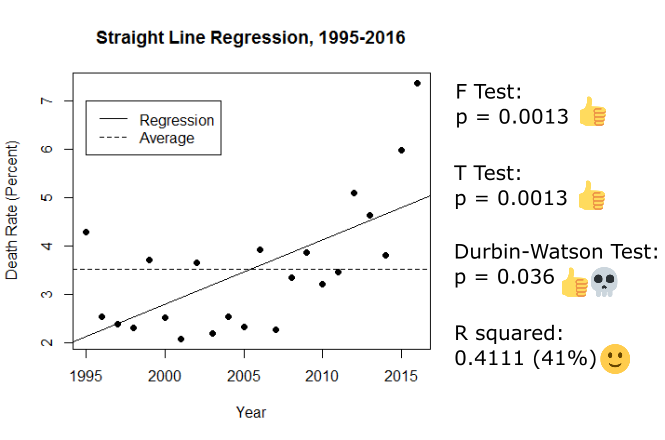
Look at those emojis! We have a slopey line and time making it be slopey! But wait - the Durbin-Watson test is also significant, and it has a skull next to it. This means that the assumption that the T and F tests were telling the truth is wrong; they might be lying :(. Since we can’t tell if those big significances are real or not, we have to throw this line out.
Even though this model isn’t reliable enough to use, it’s still worth talking about the R squared. This came in at 0.41 (41%), and is a great example of having to make a judgement call about a measurement. Is explaining 41% of the data good enough? Many statisticians would say no - they can be quite “0.8 or death” about R squared values sometimes - but since we’re working with murky sociological data, 41% actually isn’t bad.
Luckily, we’re not limited to straight lines. The death rate seems like it was stable or even going down a bit before it started increasing, so let’s see if putting a curved line through it works better:
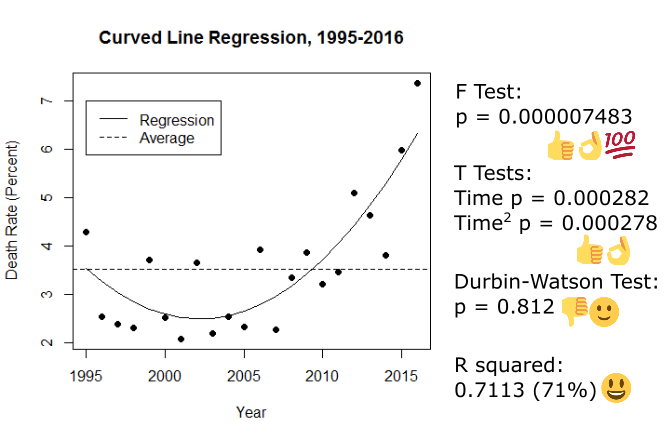
It does! There are two T tests this time around because we have to check out the significance of both time and “time squared” (the part that makes the line curve). Everything is more significant, it’s telling the truth this time (the Durbin-Watston is thumbs down but smiley because that’s the outcome we were after), and the R squared has jumped up to 0.71 (71%). This is really, really good given the kind of data we have; the curved line is both definitely not flat and explains 71% of the changes in the data cloud. We’ve found a strong, useful model.
Since the model is so good, we can use it to talk about the data. According to this analysis the death rate used to be decreasing, up until about 2003 when it flipped around to increasing again.
1.4.3 Doesn’t Gender Affect Things?
We know that gender is important overall, so it’s worth checking out whether it affects the year-to-year death rate. This isn’t something we can get hard proof for; the structure of the data makes doing those tests impossible, so we can only get an indication as to whether it might have an impact.
To do this we split the data up by gender and run two separate regressions. If the lines are different, that suggests that gender is having an impact; if the lines are the same, then gender isn't affecting them.
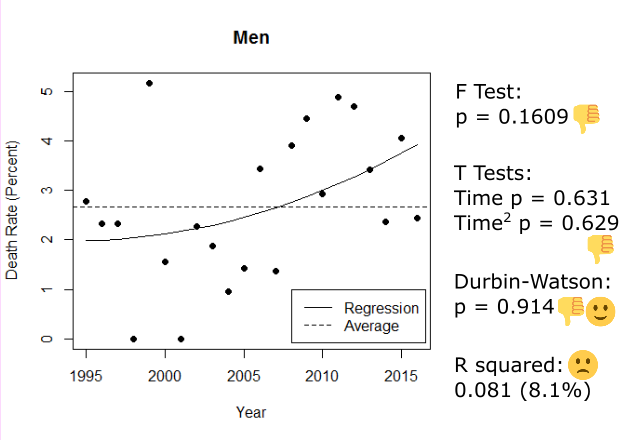
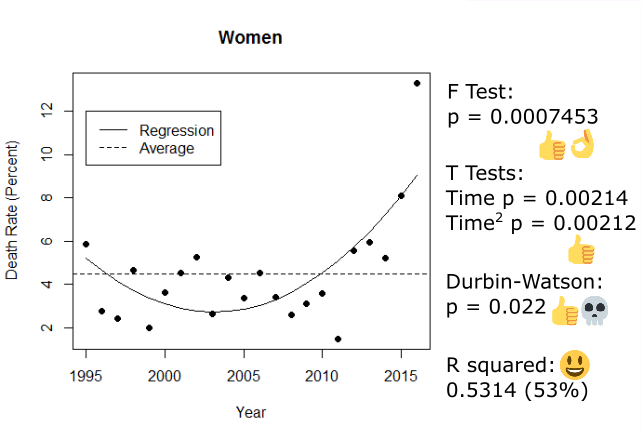
These regressions look different, for sure. One of them is significant and the other isn’t. For men, there’s no relationship between time and the yearly death rate; the fluctuations are random. However for women there is a relationship similar to the one we found in the data overall (just weaker). Unfortunately, we have the same problem as with our straight line regression; the significances in the women-only regression are lying to us, so we can’t tell if it’s actually significant and different from the insignificant men. As such, we can’t make any claims about the impact of gender on the yearly death rate :/
1.4.4 Outlier Points (Or: 2016 Is Messing Everything Up, As Usual)
Since we know what’s happening with the death rate, we can now start to work out whether 2016 was an outlier. Most people think it is, and it certainly appears to be one, but we need better evidence before we can justify kicking it out of the data.
Finding outliers requires another kind of measurement, called the Cook’s Distance. This measures the amount of undue influence a point is having on the slope of our regression line. Some influence is alright - that’s what gives the line its shape - but outlier points exert too much influence on the line and drag it out of place. Unlike the R squared, the Cook’s Distance is just a number; it starts at zero and tends to be very small.
To help us decide whether a point is an outlier, we have two handy decision-making thresholds. The first is 4/22, but that’s boring and difficult to remember so from here on it’s called the Yikes Line. If a Cook’s Distance is higher than the Yikes Line, it might be an outlier; it has enough undue influence that we should go back and check it out in the context of the data around it, and take it out if it’s being a problem. The second threshold is 1, known here as the Zoinks Line, and if a point exceeds this then it’s definitely an outlier.
Let’s check out the Cook’s Distances, as measured against the cool and accurate curved line we found earlier:
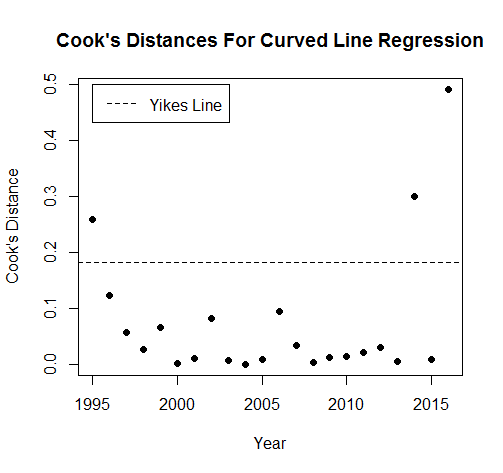
Three points break the Yikes Line; the Zoinks Line is too high to make it on to the graph. 1995, 2014 and 2016 might be outliers. If we go back to the data and check them out,

We find that 1995 is on par with years like 1999 and 2002, it just happens to be a little bit high for where it is; not a problem. 2014 is similar to these years as well, but it got flagged as an outlier for being lower than the points around it. 2016 is very high compared to the rest of the data, though; we could justify taking it out to see if it makes the regressions better.
Before we do, though, breaking things down by gender again is a good idea. After all, 2016 was allegedly an outlier for women; it might not be one for men at all, and splitting things up could provide some clarity. We take the Cook’s Distances based on the curved lines for men and women (even though the womens’ line failed, we’re allowed to use it; the bits that were broken don’t affect this measurement):
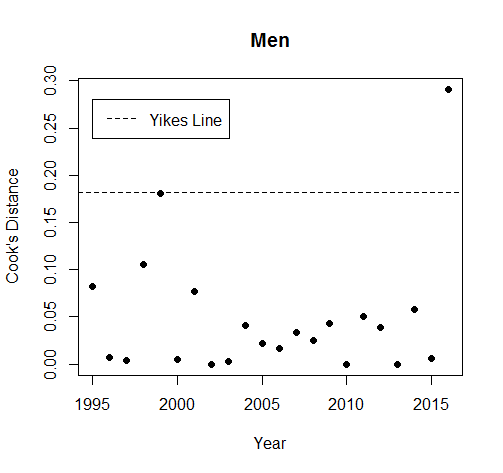
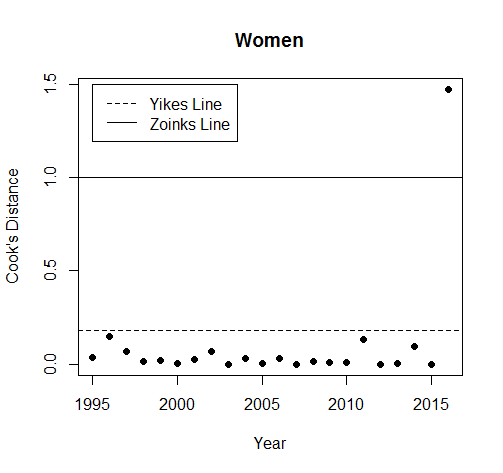
Similarly to when we drew the lines earlier, men are fine. 2016 is above the Yikes Line, but if we look at it in the data we find that it was lower than we expected. Women, on the other hand, are very much not fine. This is the first time the Zoinks line has turned up, and 2016 breaks it. There’s no doubt that, for women, 2016 is an outlier.
1.4.5 Queer Death Over Time 2: Outlier Removal Boogaloo
Since 2016 is an outlier overall and a very bad one for women, we should take it out of the regressions and re-run them.
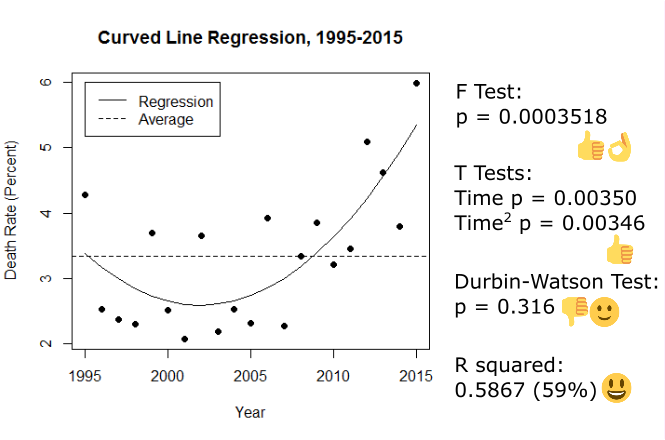
The significances and R squared all look a bit worse, although they’re still strong. The R squared has dropped to 59% from our previous 71%; despite this, 59% is still a very good amount of explanation. It’s tempting to say that the model has become worse because we took out 2016, but that’s not quite what’s happening here. Having that outlier in the data was making time seem like it was more important than it was; by taking it out, we have a more accurate model which tells us that time wasn’t as important as it seemed. This makes sense; there are lots of complicated human factors that will be affecting the death rate of queer characters in TV, and so simple change over time may not be an adequate model.
It’s important to note that we don’t know why the death rate is changing over time. We know that it is, but we can’t make the leap from what is happening to why. Digging into the causes was never the aim of this project; we were only looking to nail down what’s going on.
1.4.6 Gender Again, For The Last Time
We’ve taken out a massive gender-based outlier, so we should re-run our regressions on gender to see if they work now.
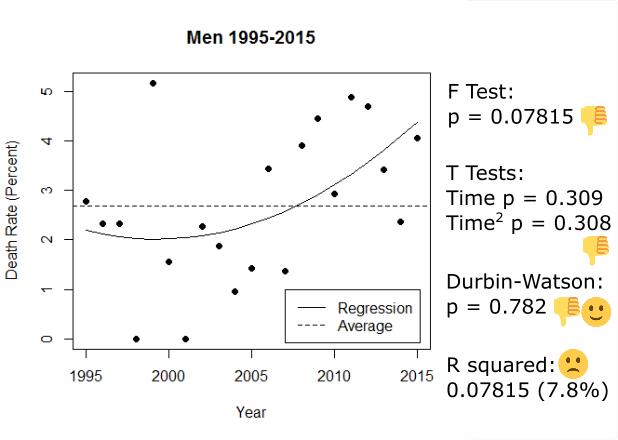
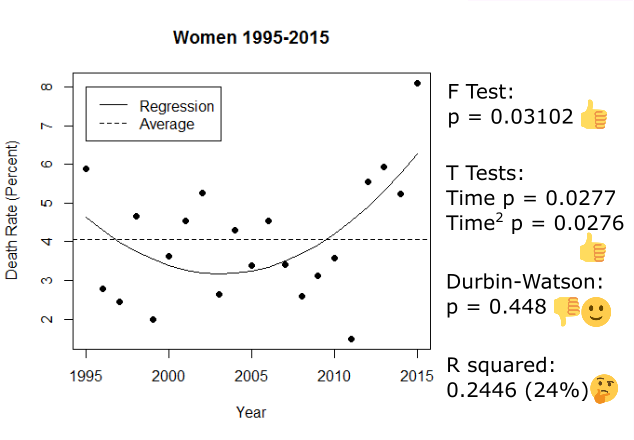
They do! There’s still no significant trend for men, but the regression for women passes our diagnostic test. These two lines are different, which is what we were looking for, so it it seems like different things are happening with the death rate between genders; the line for women also echoes the overall curve (same pattern), so it’s possible that the death rate of women is a factor that affects the overall death rate.
